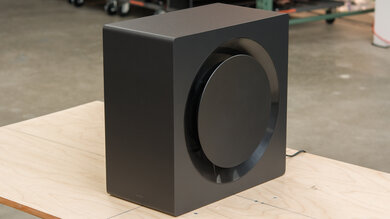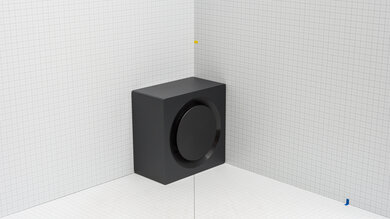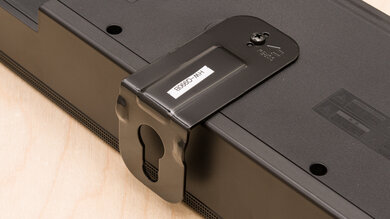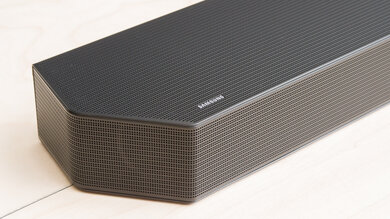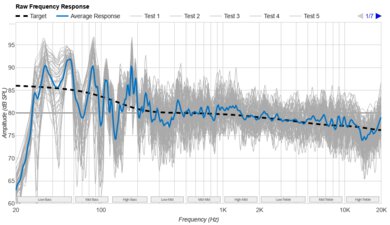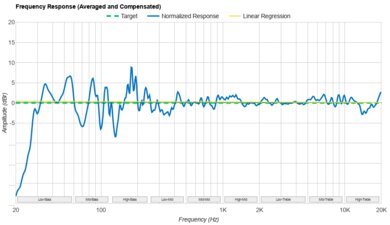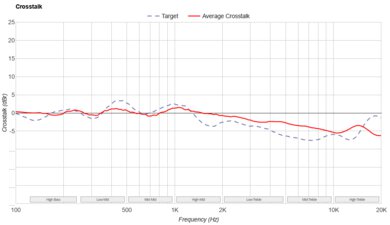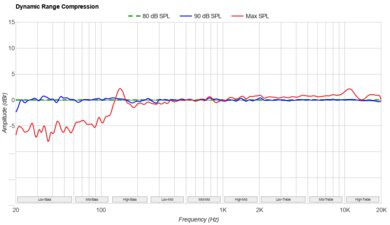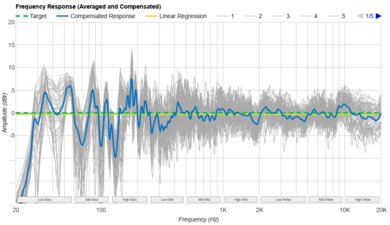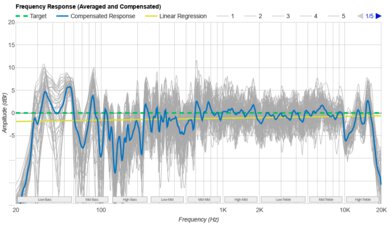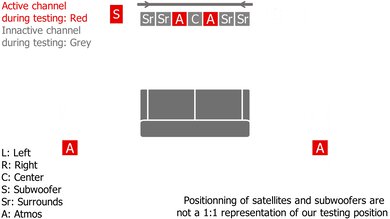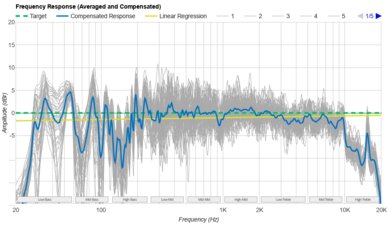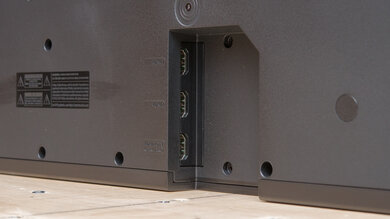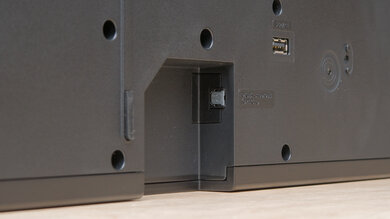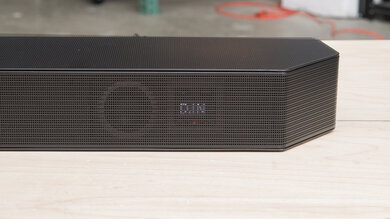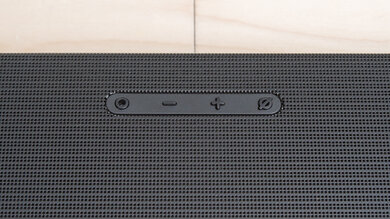The Samsung HW-Q600C/Q60CC is a 3.1.2 setup with the manufacturer's Acoustic Beam technology, which uses side-firing drivers built into the bar itself to send audio through a 'beam' and out a series of up-firing drivers for a more immersive sound. This mid-range offering still comes with the manufacturer's signature sound enhancement features, like a graphic EQ, as well as support for more advanced audio formats like Dolby Atmos. You'll have to purchase rear speakers separately, though.
Our Verdict
The Samsung HW-Q600C is good for mixed usage. This 3.1.2 soundbar has a discrete center channel to improve vocal quality in movies and TV shows. Its bass-heavy sound also brings a little extra punch to music, and there are many customization tools on hand to get the sound you want. While it supports Dolby Atmos content, it doesn't provide the most immersive listening experience. You'll have to add on separate satellites to improve its surround sound.
- Graphic EQ.
- Dolby Atmos support.
- Downmixes surround sound.
The Samsung HW-Q60CC is great for dialogue-centric TV shows and podcasts. This 3.1.2 setup has a discrete center channel to improve vocal reproduction in the mix. The balanced and even sound ensures that dialogue is reproduced with clarity and accuracy. You can even use its Voice Enhance tool to make dialogue stand out. Unfortunately, there's high latency via HDMI In, which can cause your audio and visuals to be out of sync.
- Graphic EQ.
- Dialogue enhancement tool.
- High latency via HDMI In.
The Samsung HW-Q60CC is good for music. Out-of-the-box, this soundbar has a bass-heavy sound that packs extra punch into the mix. Voices and lead instruments are clearly and accurately reproduced, and there are a lot of sound customization tools on hand to make the most of its performance. That said, this soundbar lacks room correction compared to more premium models, so it sounds a little different depending on the room you're in.
- Graphic EQ.
- Gets loud.
- No room correction.
The Samsung HW-Q60CC is decent for movies. This 3.1.2 setup uses the manufacturer's Acoustic Beam technology to simulate height with content like Dolby Atmos. It doesn't bring as much height as more premium models, so you don't get the same life-like feel with your movies. Also, 5.1 surround sound formats like Dolby Digital are downmixed into stereo, which doesn't sound as clear or real. Still, dialogue is accurately reproduced, and there's some rumble in the bass during action scenes.
- Gets loud.
- Dolby Atmos support.
- No room correction.
- Downmixes surround sound.
Changelog
-
Updated Oct 06, 2025:
After retesting, we've updated Audio Format Support: ARC/eARC and Audio Format Support: HDMI In to remove DTS:X and DTS-HD MA as being supported because these are downsampled to DTS. These same boxes were updated to change PCM support to 7.1 (rather than 5.1). The Video Passthrough To TV results were updated to better reflect real-world usage. The Popular Soundbar Comparisons box also mentions the Samsung HW-Q600F now.
-
Updated Mar 04, 2025:
Due to a retest, we confirmed that the soundbar can do 4k at 120Hz and 1080p at 120Hz. Subsequently, we've updated the text and score in the Video Passthrough to TV section.
-
Updated Nov 21, 2024:
We've updated the Sound Enhancement Features box to add a mention of the Samsung HW-S60D.
- Updated May 21, 2024: Per TBU 1.3 methodology, we updated the text in the Stereo Sound boxes after retesting with the manufacturer's recommended settings. Also added text to Audio Latency: ARC, Audio Latency: HDMI In, and Audio Latency: Optical boxes. Some updates to the usages as well, in line with these changes.
Check Price
Differences Between Sizes And Variants
The Samsung Q60CC soundbar is available in Black, and you can see the label for the model we tested here.
Let us know in the forums if you encounter another version of this soundbar.
Popular Soundbar Comparisons
The Samsung Q60CC soundbar is the next generation of the Samsung HW-Q600B. The two models are quite similar overall, as they both have 3.1.2 setups with Acoustic Beam and Dolby Atmos support. This soundbar is an upgrade over other mid-range models like the Samsung HW-Q60C/Q6CC, which has to downmix Atmos content into stereo to play it back. Still, it doesn't bring the same life-like feel as more premium models. Although the 2025 Samsung HW-Q600F has replaced the Samsung HW-Q600C, they function very much alike. The Q600C has an overall warmer and slightly more boomy tuning, while the Q600F is a bit more balanced-sounding, but you can EQ either one pretty extensively to suit your tastes.
See also our recommendations for the best Samsung soundbars, the best soundbars for dialogue, and the best Dolby Atmos soundbars.
The biggest change between the Samsung HW-Q600F and the Samsung HW-Q600C is the Dolby Atmos tuning. The Q600F delivers a slightly more immersive height effect, but it's also tuned to sound far brighter than the boomier Q600C's Atmos sound, which doesn't quite offer the same degree of height. Still, the rest of the soundbar's channels are still present and fill out the sound, so it might be worth looking at the Q800F for the slightly better height effect. Besides that, the soundbars are very similar with similar specs and performance. You can play with the tuning of these bars to coax them to sound similar, too.
The Samsung HW-Q600C is better than the Samsung HW-Q60C, especially for height content like Dolby Atmos. The Q600C has two up-firing channels, so it doesn't have to downmix Atmos content into stereo like the Q60C. The resulting sound is more clear and lifelike. The Q600C has a better stereo soundstage, too.
The Samsung HW-Q600C and the Sonos Arc Ultra are soundbars that trade blows in several categories. The 3.1.2-channel Samsung comes with an external subwoofer, enabling the system to envelop you in rumble and thump. They're also more flexible with your setup thanks to their support for HDMI In and optical connections, and EQ functions unavailable on the Sonos. That said, the Sonos soundbar is expandable if you own compatible Sonos products, which can turn the standalone bar into the centerpiece of a surround sound setup. It also supports more wireless playback options and has side-firing drivers that can widen the perceived soundscape in supported content.
The Samsung HW-Q600C and Samsung HW-B750F are both capable soundbars with different strengths and trade-offs, so which is better depends on your core usage. The HW-Q600C is a 3.1.2 bar, meaning that surround sound is necessarily downmixed to stereo, but that 3D audio can be played back using the bar's 'beam' side-firing drivers (which don't work exactly the same as most up-firing drivers) to simulate the height dimension. It also supports far more audio formats and boasts slightly better 4k video passthrough capabilities. On the other hand, the HW-B750F has a wider stereo soundstage, gets louder, and doesn't downmix 5.1 surround sound to stereo, so movies still have channel separation. Still, it's less versatile when it comes to audio formats outside of Dolby Digital and DTS.
Test Results





